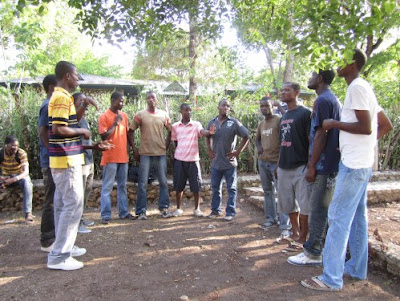We kicked off our 2011-2012 cycle of HTRIP activities on the 1st of July with a gathering of all fifty-five HTRIP community leaders. We will be working closely with forty-three communities that may graduate as many as 1,300 people this year, and we are already projecting to produce and plant as many as 380,000 trees. At the same time that we began education sessions and planned for the coming year with community leaders, we finished other summer activities to close out our 2010-2011 cycle—our final demonstration tree-planting in Barbe (on the 11th), routine experimental plot data collection (completed last Tuesday), continued sponsorship of strategic road repairs, and collection of nursery production data and tree distribution (still in progress).

HTRIP team itself does not plant very many trees—our philosophy is based on the premise that communities should be able to plant and maintain tree plots on their own—and when we finished our tenth and final demonstration plot of this year in Barbe (a remote and particularly impoverished village in Verrette’s 6th section), we reached our total of 1,863 trees for the year.
But the other shoe is coming. The trees that HTRIP technicians were involved in planting personally represent less than one hundredth of the total we expect our most recent group of program graduates to plant on their own land this summer. Thanks to the leverage that our model affords us, we can expect as many as 250,000 trees to be planted under HTRIP’s aegis this year alone. It will take months to compute the nursery production totals and survey over eight hundred new filial plots, but when the final numbers come in, we expect 2010-2011 to have been our most productive year so far. And we will do even better in 2011-2012.

While participating communities were busily planting trees this month and last, the HTRIP staff accomplished a remarkably efficient round of data collection in a spatial tree-planting experiment that was installed by Starry Sprenkle and several interns in the summer of 2009. After only two years, we already remark at the unexpectedly strong performance of the mahogany trees we planted (they continue to grow during the dry season, unlike the cedar and flame trees, and the “slow-growing” mahogany actually grew more than the other two “faster-growing” species during the first year—though in the second year they were outstripped by the flame trees). Preliminary data suggest that trees have higher growth rates and more photosynthetic activity when mixed evenly with other species, rather than planted in monocultural clumps. It is great news that preliminary conclusions like this can be available so quickly to help HTRIP better advise its participants about planting strategies, but those of us measuring the sometimes gargantuan two-year-old trees (see picture), it does not come as much of a surprise.

This month began the 2010-2011 education cycle, and the first lesson is always devoted to enpòtans pyebwa yo—the importance of trees—and an orientation to the HTRIP program. Community members learn about the causes and consequences of deforestation (for instance, charcoal use leading to soil degradation), the utility of trees (for everything from building furniture to moderating temperature), threats to tree survival (like free pasturing of livestock), and how to protect trees from those threats (tie up your goats). The lesson for August covers general care of trees.
While the tried and true HTRIP cycle of education, nurseries, terrain improvement, plantation, and follow-up is in full swing in forty-three communities this year, nine older communities that started working with us in 2006 and 2007 are piloting a more independent phase of their relationship with HTRIP. In communities like Salasse and Cayhuit, HTRIP has already been able to offer its education program to most people who are interested in planting trees (123 people in Cayhuit between 2007 and 2011!), and some community members are already planting third and fourth tree plots on their own initiative.
HTRIP is committed to developing its program in response to community needs, and as we no longer need to hold the hands of older communities as they install micro-terracing and tree plots (at which they have become quite proficient), we can focus on finding ways to make their young agro-forestry parcels more productive. Last month we installed a small pilot experiment in Source du Pont to test the viability of several shade-tolerant crops that could be ideal for planting in other young tree plots where canopy cover is significant enough to rule out traditional corn and sorghum. Paul Tompkins joined us this month from California, where he recently received his Master’s degree in Marine Science. Paul specialises in restoration ecology, and during his two-month internship he will help HTRIP plan an expansion of these shade-crop trials to ten or fifteen communities next summer.
Furthermore, we recently launched a comprehensive programme evaluation to generate a detailed plan for HTRIP over the next four, five, ten and fifteen years, through crop diversification to timber harvesting. Since 2006, we have developed a successful model for introducing basic reforestation and agro-forestry in the mountains around HAS, but as we continue to sustain that model—taking on new communities each year and progressively “graduating” old ones—it is time to look to the emerging needs of our communities, needs like shade-tolerant crops and (eventually) timber harvesting and marketing methods. This level of programme planning requires much discussion, reflection and (yes) sifting through data, but we hope to have a full report ready during the month of September. In the meantime, we welcome your questions and suggestions.
Thank you for your continuing support,
The HTRIP Staff, including Starry Sprenkle, Dan Langfitt, and Paul Tompkins.






